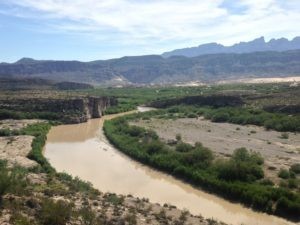Invasive Plant Removal Restores Habitat for Wildlife Communities in a Desert Floodplain Ecosystem
River floodplain vegetation is one of the highest-priority wildlife habitats in the U.S. desert southwest, both in terms of its high biological diversity and the variety of threats posed to its conservation. Researchers are studying how wildlife communities respond to ecological restoration efforts in the floodplain of the Rio Grande in Big Bend National Park on the Texas/Mexico border.
 The floodplain of the Rio Grande in Big Bend National Park on the
Texas/Mexico border is a major riparian system that has changed dramatically
over the past century due to water diversion, damming, urban expansion,
floodplain agriculture, and other impacts. These changes have facilitated the
spread of invasive plant species, which further alter hydrology, vegetation,
and habitat conditions for wildlife. Large stands of giant cane (Arundo donax) have come to dominate
significant portions of the riverbank, exacerbating stream channelization and
displacing more diverse native vegetation. Big Bend National Park in Texas and
adjacent protected areas in Mexico have undertaken a major restoration initiative,
using prescribed fire and manual treatments to remove cane stands along 118
miles of shared floodplain. An Eastern Forest Environmental Threat Assessment
Center scientist is working with partners in the National Park Service (NPS)
and California State University-L.A. to assess the impacts of the restoration
efforts on wildlife by monitoring bird and butterfly communities in relation to
treatments. Two initial project years established a baseline understanding of
how bird and butterfly species composition and diversity vary across the
landscape in relation to vegetation conditions; the next step is to examine how
these characteristics change as vegetation recovers following treatments. A
species of concern is the Yellow-billed Cuckoo (Coccyzus americanus), whose western population was recently listed
under the U.S. Endangered Species Act. Scientists are examining detailed
habitat relationships for this species, and NPS partners hope to use
information about the distribution of high-quality floodplain habitat to inform
management activities.
The floodplain of the Rio Grande in Big Bend National Park on the
Texas/Mexico border is a major riparian system that has changed dramatically
over the past century due to water diversion, damming, urban expansion,
floodplain agriculture, and other impacts. These changes have facilitated the
spread of invasive plant species, which further alter hydrology, vegetation,
and habitat conditions for wildlife. Large stands of giant cane (Arundo donax) have come to dominate
significant portions of the riverbank, exacerbating stream channelization and
displacing more diverse native vegetation. Big Bend National Park in Texas and
adjacent protected areas in Mexico have undertaken a major restoration initiative,
using prescribed fire and manual treatments to remove cane stands along 118
miles of shared floodplain. An Eastern Forest Environmental Threat Assessment
Center scientist is working with partners in the National Park Service (NPS)
and California State University-L.A. to assess the impacts of the restoration
efforts on wildlife by monitoring bird and butterfly communities in relation to
treatments. Two initial project years established a baseline understanding of
how bird and butterfly species composition and diversity vary across the
landscape in relation to vegetation conditions; the next step is to examine how
these characteristics change as vegetation recovers following treatments. A
species of concern is the Yellow-billed Cuckoo (Coccyzus americanus), whose western population was recently listed
under the U.S. Endangered Species Act. Scientists are examining detailed
habitat relationships for this species, and NPS partners hope to use
information about the distribution of high-quality floodplain habitat to inform
management activities.
Pictured: Riparian floodplain vegetation along the Rio Grande/Bravo in Mexico and Texas. Riverbank vegetation dominated by invasive giant cane (Arundo donax) can give way to a more diverse mix of native vegetation after prescribed fire and manual treatments. Photo by Lars Pomara, USDA Forest Service.
External Partners/Collaborators: National Park Service; Wood Lab of Avian Ecology and Conservation at California
State University, Los Angeles
Contact: Lars Pomara, Ecologist, lazarus.y.pomara@usda.gov



